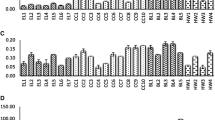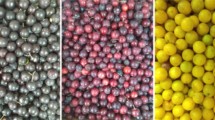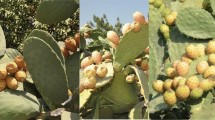Abstract
It is of great importance that people eat healthy in order to reduce the negative effects of ecological changes and technological developments in the world. Therefore, the interest in fruits, which are rich in biochemical contents, is increasing day by day. Among these fruit types, cornelian cherry has an important potential. In this study, antioxidant, total monomeric anthocyanin, phenolic compounds, organic acids and vitamin C contents of fruits belonging to 25 cornelian cherry genotypes were determined. Principal component and cluster analyzes were performed to determine the correlation between compounds. In the study, when the organic acid content of the fruits was examined, it was seen that tartaric acid and citric acid followed this acid with the highest malic acid content. It was determined that ellagic acid, catechin and chlorogenic acid, which are specific phenolics, are generally higher than other phenolic compounds. Total anthocyanin content showed great variation between genotypes and ranged from 3.79 µg cy-3-glu/g (14BL06) to 77.65 µg cy-3-glu/g. TEAC values were determined between 4.14 and 11.03 µmol TE/g and FRAP values are between 3.37 and 10.50 µmol TE/g. According to principal component analysis, the correlation between total antioxidant, total phenolic and total anthocyanins was 94.70%. While the correlation between phenolic compounds was determined as 42.40%, it was determined that the correlation between organic acids was 59%. As a result, it has been revealed that cornelian cherry gene sources are rich in biochemical contents and can be used effectively in functional foods.






Similar content being viewed by others
References
Andersen ØM (2001) Anthocyanins. Encyclop Life Sci. https://doi.org/10.1038/npg.els.0001909
Badalica-Petrescu M, Dragan S, Ranga F, Fetea F, Socaciu C (2014) Comparative HPLC-DAD-ESI (+) MS fingerprint and quantification of phenolic and flavonoid composition of aqueous leaf extracts of Cornus mas and Crataegus monogyna, in relation to their cardiotonic potential. Notulae Botanicae Horti Agrobotanici Cluj-Napoca 42(1):9–18
Bayram HM, Öztürkcan SA (2020a) Bioactive components and biological properties of Cornelian cherry (Cornus mas L.): a comprehensive review. J Funct Foods 75:1–27
Bayram HM, Öztürkcan SA (2020b) Antosiyanince zengin kiraz grubu meyvelerin insan sağlığı üzerine etkilerini inceleyen klinik çalışmalara bir bakış. Igusabder 11:230–254
Baytop T (1984) Türkiye’de bitkilerle tedavi. İstanbul Üniversitesi Eczacılık Fakültesi Yayınları 40:298–299
Benzie IFF, Strain JJ (1996) The ferric reducing ability of plasma (FRAP) as a measure of “antioxidant power”: The FRAP assay. Anal Biochem 239:70–76
Bevilacqua AE, Califano AN (1989) Determination of organic acids in dairy products by high performance liquid chromatography. J Food Sci 54(4):1076–1076
Blando F, Oomah BD (2019) Sweet and sour cherries: Origin, distribution, nutritional composition and health benefits. Trends Food Sci Technol 86:517–529
Brindza P, Horcin V, Brindza J, Tóth D, Gazo J, Holecyová J (2005) Cornelian cherry (Cornus mas L.) as alternative species for utilization in diet, landscape architecture and pharmacy. In proceedings of the seventh international botanical congress, Vienna, Austria, July pp 17–23
Celep E, Aydın A, Yesilada E (2012) A comparative study on the in vitro antioxidant potentials of three edible fruits: Cornelian cherry, Japanese persimmon and cherry laurel. Food Chem Toxicol 50(9):3329–3335
Cemeroğlu B (2007) Gıda analizleri. Gıda Teknolojisi Dergisi Yayınları 34:168–171
Cosmulescu S, Trandafir I, Cornescu F (2019) Antioxidant capacity, total phenols, total flavonoids and colour component of cornelian cherry (Cornus mas L.) wild genotypes. Notulae Botanicae Horti Agrobotanici Cluj-Napoca 47(2):390–394
Czerwinska ME, Melzig MF (2018) Cornus mas and Cornus officinalis—analogies and differences of two medicinal plants traditionally used. Front Pharmacol 9:1–28
De Biaggi M, Donno D, Mellano MG, Riondato I, Rakotoniaina EN, Beccaro GL (2018) Cornus mas (L.) fruit as a potential source of natural health-promoting compounds: physico-chemical characterisation of bioactive components. Plant Foods Human Nutrition 73(2):89–94
Demir F, Kalyoncu IH (2003) Some nutritional, pomological and physical properties of cornelian cherry (Cornus mas L.). J Food Eng 60:335–341
Dinda B, Kyriakopoulos AM, Dinda S, Zoumpourlis V, Thomaidis NS, Velegraki A, Markopoulos C, Dinda M (2016) Cornus mas L. (cornelian cherry), an important European and Asian traditional food and medicine: ethnomedicine, phytochemistry and pharmacology for its commercial utilization in drug industry. J Ethnopharmacol 193:670–690
Dragovic-Uzelac V, Levaj B, Bursac D, Pedisic S, Radojcic I, Bisko A (2007) Total phenolics and antioxidant capacity assays of selected fruits. Agric Conspec Sci 72(4):279–284
Enache IM, Benito-Román Ó, Coman G, Vizireanu C, Stănciuc N, Andronoiu DG, Mihalcea L, Sanz MT (2021a) Extraction optimization and valorization of the cornelian cherry fruits extracts: evidence on antioxidant activity and food applications. Appl Sci 11(22):10729
Enache IM, Coman G, Roșca S, Vizireanu C, Mihalcea L (2021b) The optimization of a conventional extraction of bioactive compounds from Cornus mas by RSM and the determination of favourability factors by GIS technique. Notulae Botanicae Horti Agrobotanici Cluj-Napoca 49(2)
Fadda A, Mulas M (2010) Chemical changes during myrtle (Myrtus communis L.) fruit development and ripening. Sci Hortic 125(3):477–485
Giusti MM, Wrolstad RE (2001) Characterization and measurement of anthocyanins by UV‐visible spectroscopy. Current protocols in food analytical chemistry (1):F1–2. https://doi.org/10.1002/0471142913.faf0102s00
Gómez-Maqueo A, Escobedo-Avellaneda Z, Welti-Chanes J (2020) Phenolic compounds in mesoamerican fruits—characterization, health potential and processing with innovative technologies. Int J Mol Sci 21(21):1–41
Güzel N (2021) Morphometric and physico-chemical properties of cornelian cherry (Cornus mas L.) grown in Çorum, Turkey. Akademik Gıda 19(4):373–380
Hassanpour H, Yousef H, Jafar H, Mohammad A (2011) Antioxidant capacity and phytochemical properties of cornelian cherry (Cornus mas L.) genotypes in Iran. Sci Hortic 129(3):459–463
Holton TA, Cornish EC (1995) Genetics and biochemistry of anthocyanin biosynthesis. Plant Cell 7(7):1071
Islamovic A, Mlaco M, Berbic N, Begic-Akagic A, Orucevic S, Bulbulusic A, Ekeberg D, Drkenda P (2014) Seasonal variation of the physical and chemical parameters of wild genotypes of cornelian cherry (Cornus mas L.). J Int Sci Publ Agric Food 2:466–471
Jurečková Z, Diviš P, Cetkovská J, Vespalcová M, Pořízka J, Reznicek V (2021) Fruit characteristics of different varieties of cornelian cherry (Cornus mas L.) cultivated in the Czech republic. Erwerbs-Obstbau 63:143–149
Kazimierski M, Regula J, Molska M (2019) Cornelian cherry (Cornus mas L.)–characteristics, nutritional and pro–health properties. Acta Scientiarum Polonorum Technologia Alimentaria 18:5–12
Kelley DS, Adkins Y, Laugero KD (2018) A review of the health benefits of cherries. Nutrients 10(3):368
Klimenko S (2004) The cornelian cherry (Cornus mas L.): Collection, preservation, and utilization of genetic resources. J Fruit Ornamental Plant Res 12:93–98
Krivoruchko E, Samoilova V, Kovalev V (2011) Constituent composition of essential oil from Cornus mas flowers. Chem Nat Compd 47(4):646–647
Kucharska AZ, Szumny A, Sokół-Łętowska A, Zając K (2009) Fatty acid compositions of seed oils of cornelian cherry (Cornus mas L.). Acta Biochim Pol 56(2):21–22
Kucharska AZ, Szumny A, Sokół-Łętowska A, Piórecki N, Klymenko SV (2015) Iridoids and anthocyanins in cornelian cherry (Cornus mas L.) cultivars. J Food Compos Anal 40:95–102
Kutlu N, Isci A, Sakiyan O, Yilmaz AE (2021a) Extraction of phenolic compounds from cornelian cherry (Cornus mas L.) using microwave and ohmic heating assisted microwave methods. Food Bioprocess Technol 14:650–664
Kutlu N, Isci A, Sakiyan O, Yilmaz AE (2021b) Effect of ohmic heating on ultrasound extraction of phenolic compounds from cornelian cherry (Cornus mas). J Food Process Preserv 45(10):e15818
Laleh GH, Frydoonfar H, Heidary R, Jameei R, Zare S (2006) The effect of light temperature, pH and species on stability of anthocyanin pigments in four berneris species. Pak J Nutr 5:90–92
Mattheis JP, Rudell DR, Buchanan DA (2004) Ethylene intensifies but is not a requirement for methyl jasmonate-enhanced anthocyanin synthesis by “fuji” apple fruit. Acta Hort 636:455–460
Odžaković B, Sailović P, Bodroža D, Kojić V, Jakimov D, Kukric Z (2021) Bioactive components and antioxidant, antiproliferative, and antihyperglycemic activities of wild cornelian cherry (Cornus mas L.). Food Chem 40(2): 221–230
Özgen M, Reese RN, Tulio AZ, Miller AR, Scheerens JC (2006) Modified 2,2-azino-bis-3-ethylbenzothiazoline-6-sulfonic acid (ABTS) method to measure antioxidant capacity of selected small fruits and comparison to ferric reducing antioxidant power (FRAP) and 2,2’-diphenyl-1-picrylhydrazyl (DPPH) methods. J Agric Food Chem 54:1151–1157
Pantelidis GE, Vasilakakis M, Manganaris GA, Diamantidis GR (2007) Antioxidant capacity, phenol, anthocyanin and ascorbic acid contents in raspberries, blackberries, red currants, gooseberries and cornelian cherries. Food Chem 102(3):777–783
Petkova N, Ognyanov MH (2018) Phytochemical characteristics and in vitro antioxidant activity of fresh, dried and processed fruits of cornelian cherries (Cornus mas L.). Bul Chem Commun 50:302–307
Popovic BM, Stajner D, Slavko K, Sandra B (2012) Antioxidant capacity of cornelian cherry (Cornus mas L.)—comparison between permanganate reducing antioxidant capacity and other antioxidant methods. Food Chem 134:734–741
Prior RL, Wu X, Schaich K (2005) Standardized methods for the determination of antioxidant capacity and phenolics in foods and dietary supplements. J Agric Food Chem 53:4290–4302
Rivero-Perez MD, Muniz P, Gonzalez-Sanjose ML (2007) Antioxidant profile of red wines evaluated by total antioxidant capacity, scavenger activity, and biomarkers of oxidative stress methodologies. J Agric Food Chem 55(14):5476–5483
Rodriguez-Delgado MA, Malovana S, Perez JP, Borges T, Montelongo FG (2001) Separation of phenolic compounds by high-performance liquid chromatography with absorbance and fluorimetric detection. J Chromatogr A 912(2):249–257
Rop O, Mlcek J, Kramarova D, Jurikova T (2010) Selected cultivars of cornelian cherry (Cornus mas L.) as a new food source for human nutrition. Afr J Biotechnol 9(8):1205–1210
Savran HS (1999) Nar suyunda organik asit dağılımı. Yüksek Lisans Tezi, Ankara Üniversitesi Fen Bilimleri Enstitüsü, Ankara, Türkiye
Seçim Y (2017) Türk mutfağında kullanılan bazı fonksiyonel gıdalar ve özellikleri. Uluslararası Global Turizm Dergisi 2(1):1–9
Singleton VL, Rossi JL (1965) Colorimetry of total phenolics with phosphomolybdic-phosphotungstic acid reagents. Am J Enol Vitic 16:144–158
Spychaj R, Kucharska AZ, Szumny A, Przybylska D, Pejcz E, Piorecki N (2021) Potential valorization of cornelian cherry (Cornus mas L.) stones: roasting and extraction of bioactive and volatile compounds. Food Chem 358:129802
Stankovic MS, Zia-Ul-Haq M, Bojovic BM, Topuzovic MD (2014) Total phenolics, flavonoid content and antioxidant power of leaf, flower and fruits from cornelian cherry (Cornus mas L.). Bulgarian J Agric Sci 20(2):358–363
Szczepaniak OM, Kobus-Cisowska J, Kusek W, Przeor M (2019) Functional properties of cornelian cherry (Cornus mas L.): a comprehensive review. Eur Food Res Technol 245:2071–2087
Tural S, Koca I (2008) Physico-chemical and antioxidant properties of cornelian cherry fruits (Cornus mas L) grown in Turkey. Sci Hortic 116(4):362–366
TÜİK (2016) Agricultural structure production, price, value (Publishing Turkish Statistical Institute Web, 2016). Accessed 11 August 2016. https://data.tuik.gov.tr
TÜİK (2021) Agricultural structure production (Publishing Turkish Statistical Institute Web, 2021). https://data.tuik.gov.t. Accessed 22 April 2021.
Urbstaite R, Raudone L, Janulis V (2022) Phytogenotypic anthocyanin profiles and antioxidant activity variation in fruit samples of the American cranberry (Vaccinium macrocarpon Aiton). Antioxidants 11(2):250
Wickham H (2016) Ggplot2: elegant graphics for data analysis. Springer, New York
Yarılgaç T, Kadimand H, Ozturk B (2019) Role of maturity stages andmodified-atmosphere packaging on the qualityattributes of cornelian cherry fruits (Cornus mas L.) throughout shelf life. J Sci Food Agric 99:421–428
Yılmaz KU, Ercişli S, Zengin Y, Şengül M, Kafkas EY (2009) Preliminary characterisation of cornelian cherry (Cornus mas L.) genotypes for their physico-chemical properties. Food Chem 114(2):408–412
Zia MP, Alibas I (2021) The effect of different drying techniques on color parameters, ascorbic acid content, anthocyanin and antioxidant capacities of cornelian cherry. Food Chem 364:130358
Acknowledgements
This research work was financially supported by the Scientific Research Projects of Bolu Abant İzzet Baysal University.
Funding
The authors have not disclosed any funding.
Author information
Authors and Affiliations
Contributions
AT: Conceptualization, Methodology, Investigation, Supervision, Experiment, Writing – original draft. AT: Investigation, Experiment, Resources. MG: Conceptualization, Methodology, Formal analysis, Supervision, Writing—review & editing.
Corresponding author
Ethics declarations
Conflict of interest
The authors report no declarations of interest.
Additional information
Publisher's Note
Springer Nature remains neutral with regard to jurisdictional claims in published maps and institutional affiliations.
Rights and permissions
Springer Nature or its licensor (e.g. a society or other partner) holds exclusive rights to this article under a publishing agreement with the author(s) or other rightsholder(s); author self-archiving of the accepted manuscript version of this article is solely governed by the terms of such publishing agreement and applicable law.
About this article
Cite this article
Taş, A., Gundogdu, M. Physiological characterization of wild cornelian cherry genotypes in terms of phenolic compounds, organic acids and antioxidants. Genet Resour Crop Evol 70, 2491–2509 (2023). https://doi.org/10.1007/s10722-023-01578-9
Received:
Accepted:
Published:
Issue Date:
DOI: https://doi.org/10.1007/s10722-023-01578-9




